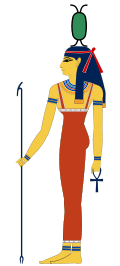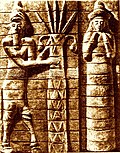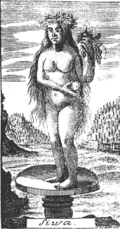List of 999 women of the Heritage Floor / Primordial Deity
This list describes the place setting for the primeval goddess on the table of the art installation The Dinner Party by Judy Chicago . It is part of the list of 999 women on the Heritage Floor who are assigned to the respective place settings on the table. The names of the 999 women are on the tiles of the Heritage Floor, which is arranged below the table and belongs to the art installation.
description
The installation consists of a three-sided table, each with 13 historical or mythological personalities, thus a total of 39 people, from prehistory to the women's rights movement . These people were assigned a place setting at the table, consisting of an individually designed table runner, an individually designed plate, a goblet, knife, fork, spoon and serviette. The first page of the table is devoted to prehistory up to the Roman Empire , the second to Christianization up to the Reformation and the third from the American Revolution to the women's movement. Each place setting on the table is assigned additional personalities who have received an entry on the tiles of the Heritage Floor, which occupies the space under the table and the center of the space between the sides of the table. This list includes the personalities who are assigned to the original goddess's place setting. Your seat is on the first side of the table.
Hints
In addition to the names as they are used in German transcription or in scientific usage, the list shows the spelling chosen by Judy Chicago on the tiles.
The information on women who do not yet have an article in the German-language Wikipedia is referenced by the individual references listed under comments . If individual information in the table is not referenced via the main article, additional individual references are given at the relevant point. If there are any discrepancies between the information provided in Wikipedia articles and the descriptions of the work of art on the Brooklyn Museum website , this will also be indicated under Comments.
Place setting for the primordial goddess
Oral traditions and archaeological reports provide information about the primordial deities of man. These include stories about the "old woman" of the Aborigines in Australia. She represents the original idea of a mother goddess who was responsible for the creation of the earth and all of its flora and fauna with a sacred feminine power . The earth goddess was the universal soul of fertility, she took plant, animal and human matter into death in order to create new life from it.
According to these ideas, the goddess as the divine creator was reflected in the body of every woman. The cycles of nature are found in the cycles of the female body and in traditional works of art. In cave drawings or figurines , stylized images of the female body were depicted, which mostly only emphasized one part of the body, such as the breasts, genitals or buttocks.
With the beginning of sedentarism and the end of nomadic life in the late Paleolithic a shift in ideological ideas went hand in hand. In addition to the original goddesses, other deities arose.
The place setting of the primordial goddess on the table is reminiscent of the early divine tradition, when women were the creators of all life on earth. The plate of the original goddess symbolizes the connection between the female body and mother earth . It is reminiscent of meat and also of rock and, according to Judy Chicago, is said to be reminiscent of the "primordial vagina", the original source of all life.
The table runner reminds of the importance of women's work in the Paleolithic. The spiral, which is wound around the initial letter "P" of the name "Primordial Goddess", is said to represent early baskets and pots that were made using spiral shapes. As a symbol it should stand for the goddess and sacred femininity. On the runner there are calf skins, which represent early clothing and are adorned with cowries , which are an ancient symbol of female fertility. Fur, a soft, pleasingly tactile material, is also associated with making clothes and with women and women’s work.
| Surname | Spelling on the tile | Date of birth | cultural spatial assignment | Remarks | image |
|---|---|---|---|---|---|
| Ajyhyt | Ajysyt | N / A | Siberian shamanism | Fertility deity of the Turkish Yakuts from the Lena region in Siberia. The name means "obstetrician" and can also be called "mother of the cradles".
She was responsible for giving birth to the soul of a newborn child. According to legend, she lived on a mountain from which she controlled the fate of humanity. She is said to have kept a golden book in which she recorded every birth. |
|
| Atira | Atira | N / A | North American deity of the Pawnee | Goddess of the earth in Pawnee mythology.
Atira, her name means "heavenly vault", is mother earth and a member of the council of gods in the mythology of the Pawnee . Her husband is Tirawa, the creator god. For the Pawnee, Atira's earthly manifestation is maize . |

|
| Eurynomials | Eurynomials | N / A | Greek mythology | Creator of all things, primeval goddess of the Pelasgians . As part of the Pelasgian myth of origin , it ruled Mount Olympus in pre-Greek times . It emerged naked from the primal chaos and first of all separated the sky from the waters and separated the light from the darkness. | |
| Gaia | Gaea | N / A | Greek mythology | The personified earth and one of the first deities. Her name is of Indo-European origin and possibly means the woman who gave birth. |

|
| Gefion | Gebjon | N / A | Norse mythology | Aesir maiden , protector of virgins , who owns all who die unmarried, and goddess of family and happiness. It is considered as pure as the morning dew. |

|
| Ilmatar | Ilmatar | N / A | Finnish mythology | Virgin female spirit of the air, who created the world from seven cosmic eggs and thus the primal mother of Finnish mythology. |

|
| Nammu | Nammu | N / A | Sumerian mythology | Goddess of creation . If the Babylonian creation myth Enûma elîsch is , as it is supposed, based on a Sumerian myth, Nammu is the Sumerian deity of the primordial sea , who gave birth to the gods An (heaven) and Ki (earth) and the first gods. | |
| Neith | Neith | N / A | Egyptian mythology | She is one of the oldest attested goddesses and was worshiped as the goddess of war, creator goddess, mother goddess, goddess of Lower Egypt and goddess of the dead in the course of Egyptian history . |

|
| Ninursanga | Aruru | N / A | Akkadian mythology | Mountain and mother goddess . She is one of the leading female gods and is also named with the epithet "Mother of the Gods". In her function as the goddess of childbirth, she is also known as the “mother of all children”.
In the dinner table, Aruru is described as the goddess of creation, which has its origins in the Akkadian culture that developed around the ancient Mesopotamian city of Akkad . It has parallels in Sumerian and Babylonian cultures. In the Gilgamesh epic , she is named as the creator of Enkidu, the mythical savage raised by animals. Aruru formed it from a lump of clay in the image of Anu, the lord of heaven and king of the gods. |

|
| Ninursanga | Ninhursaga | N / A | Sumerian mythology | Mountain and mother goddess . She is one of the leading female gods and is also named with the epithet "Mother of the Gods". In her function as the goddess of childbirth, she is also known as the “mother of all children”.
In the dinner table, Ninhursaga is described as the Sumerian counterpart of Aruru. She is considered the goddess Ki. She was the wife of Enki, the god of culture, and with him created plant life, which was embodied by her daughter Ninsar, the goddess of the willow tree. She was also married to Enlil, Enki's half-brother, and had many children. |
|
| Groove | Groove | N / A | Egyptian mythology | Goddess of Heaven. She symbolizes the firmament and was seen as the mother of the stars . |

|
| Ometeotl | Omeciuatl | N / A | Aztec gods | Dual god, to whom a higher power than most of the other gods was assigned. Ometeotl consisted of a male component, Ometecutli (“two-man”), and its female counterpart, Omecihuatl (“two-woman”). | |
| Siva | Siva | N / A | West Slavic Mythology | Main goddess of the West Slavic tribe of polabians . |

|
| Tefnut | Tefnut | N / A | Egyptian mythology | Creator deity of the Heliopolitan cosmogony . It symbolized the fire.
In the art installation, Tefnut is described as the Egyptian goddess of water and fertility. The sun god Ra nieste and Schu was born, then he cleared his throat and Tefnut was born. With her brother Schu, she created Geb and Nut . Tefnut is often depicted as a cat, a symbol of war, relating to a myth in which she fought with Shu and fled Egypt. |

|
| Tiamat | Tiamat | N / A | Babylonian mythology | Goddess. She embodies the salt water and forms the counterpart to her husband Abzu , the fresh water . |

|
- Individual evidence
- ↑ Brooklyn Museum: Primordial Goddess. In: brooklynmuseum.org. Retrieved September 29, 2019 .
- ↑ Julie Loar: Goddesses for Every Day: Exploring the Wisdom and Power of the Divine Feminine around the World . New World Library, 2010, ISBN 978-1-57731-951-1 , pp. 207 ( books.google.de ).
- ↑ Brooklyn Museum: Ajysyt. In: brooklynmuseum.org. Retrieved September 22, 2019 .
- ↑ Patricia Monaghan: Encyclopedia of Goddesses and Heroines [2 volumes] . ABC-CLIO, 2009, ISBN 978-0-313-34990-4 , pp. 534 ( books.google.de ).
- ↑ Brooklyn Museum: Atira. In: brooklynmuseum.org. Retrieved September 29, 2019 .
- ↑ Brooklyn Museum: Aruru. In: brooklynmuseum.org. Retrieved September 29, 2019 .
- ↑ Brooklyn Museum: Ninhursaga. In: brooklynmuseum.org. Retrieved September 29, 2019 .
- ↑ Brooklyn Museum: Tefnut. In: brooklynmuseum.org. Retrieved September 29, 2019 .
Web links
- Brooklyn Museum, Primordial Goddess
- The Dinner Party on the website of Through the Flower , Judy Chicago's non-profit organization
